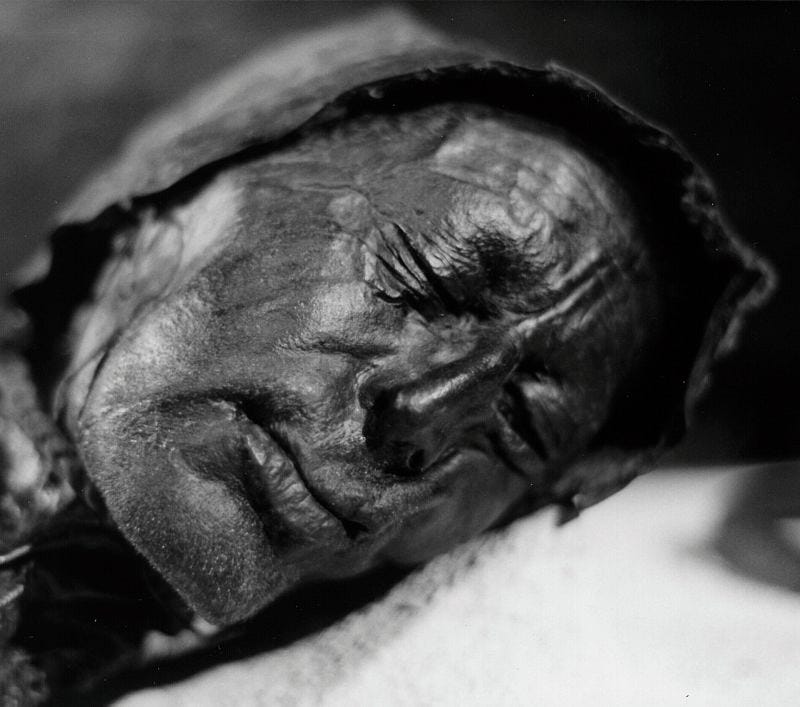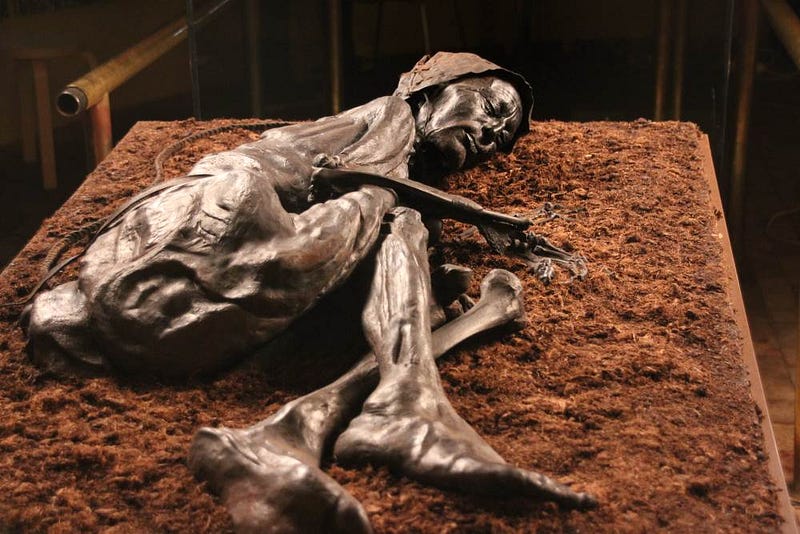The Mystifying Tollund Man: Preserved Through the Ages
Written on
Chapter 1: The Discovery of the Tollund Man
On May 8, 1950, peat cutters Viggo and Emil Hojgaard stumbled upon a body near Silkeborg, Denmark. Initially presumed to be a recent homicide, authorities quickly realized this was no ordinary crime scene. Instead, it would take the expertise of archaeologists to unravel the mystery.
The body, buried 2.5 meters underground and curled in a fetal position, wore a sheepskin cap and had a noose around its neck. With reddish hair, the remains sparked immediate intrigue. Officials from the Silkeborg Museum began a thorough investigation, pondering whether this was an ancient murder victim or a figure executed long ago.
Upon further examination, they determined the body was over 2,400 years old, leading them to nickname him the Tollund Man. But who was he, and how was his body preserved so well?
Section 1.1: The Identity of the Tollund Man
After his discovery, local media referred to him as "the man from Bogville." Renowned Danish archaeologist Professor P. V. Glob was called to analyze the remains and ultimately coined the term "Tollund Man," in honor of the village from which the peat cutters hailed.
Despite appearing to be a murder victim, forensic analysis indicated he was an adult, likely aged between 30 and 40 years at the time of death. His remarkably preserved facial features and the presence of wisdom teeth confirmed his adulthood. Radiocarbon dating revealed he lived during the Pre-Roman Iron Age, between 375 and 210 BCE.

What makes the preservation of the Tollund Man's body fascinating is the bog environment in which he was found. Unlike the elaborate embalming methods of ancient Egyptians, the acidic conditions of peat, paired with low oxygen levels and a colder climate, created an ideal setting for preservation. Sphagnum moss, abundant in these bogs, releases polysaccharides that inhibit bacterial decay, explaining why even the noose around his neck and his leather cap remained intact.
Section 1.2: The Circumstances of His Death

The evidence suggests that the Tollund Man met his end by hanging, although his cervical vertebrae were found intact. This raises questions: Was he murdered, or was this a public execution? The Roman historian Tacitus noted that the Semnones, a Germanic tribe, executed traitors and criminals by hanging, disposing of their bodies in nearby wetlands.
However, the careful positioning of the Tollund Man’s body—curled up and with eyes and mouth closed—implies that he was treated with dignity after death. This contrasts sharply with the treatment of typical criminals in ancient times, who were often discarded without ceremony.
Despite Tacitus' account being written centuries later, archaeological findings of similar bog bodies across Northern Europe hint that the Tollund Man might have been a victim of ritualistic sacrifice. Ancient Celtic animists revered marshes and bogs, often offering humans to appease their deities, linking such practices to kingship and fertility rituals.
Chapter 2: The Last Meal of the Tollund Man

Analysis of the Tollund Man's gut revealed his last meal—a porridge made primarily of barley, flax, and various wild weed seeds—consumed just hours before his death. The findings suggest that the society responsible for his sacrifice viewed him with little regard, as evidenced by the low quality of his final meal.
Miranda Aldhouse-Green, an expert in history and archaeology, posits that the nature of his meal might indicate societal decline and food scarcity. The porridge's carbonized remains point to careless preparation, suggesting that the society that sacrificed him did not even extend the courtesy of a proper last meal.
Interestingly, no hallucinogens or painkillers were found in his stomach, unlike other ritual sacrifice victims from the same period. This omission raises further questions about his societal status and the treatment he received.
The Tollund Man stands as the most well-preserved bog body discovered to date, providing invaluable insight into the ancient Celtic civilization that thrived in Northern Europe before the rise of the Roman Empire.
The analysis of ancient remains, such as those of the Tollund Man, can shed light on the lives and struggles of our ancestors, revealing that they faced many of the same challenges we encounter today.
Make sure to check out the story of Iceman Ötzi, whose medical history illustrates the continuity of human ailments through the ages.
References
- Tollund Man — A Face from Prehistoric Denmark.
- Last meal of ancient human sacrifice victim ‘Tollund Man’ revealed in exquisite detail by Live Science.
- P.V. Glob: The Bog People: Iron-Age Man Preserved, New York Review of Books (New York) 2004.
- Miranda Aldhouse-Green Bog Bodies Uncovered: Solving Europe’s Ancient Mystery, Thames and Hudson 2015.
- Nielsen et al (2021) The last meal of Tollund Man: new analyses of his gut content, Antiquity.